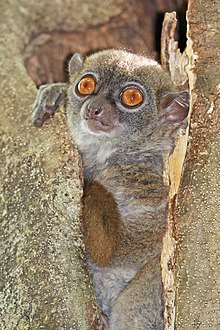Sportive lemur
This article needs additional citations for verification. (December 2014) |
| Sportive lemurs | |
|---|---|

| |
| Ankarana sportive lemur (L. ankaranensis) | |
| Scientific classification | |
| Domain: | Eukaryota |
| Kingdom: | Animalia |
| Phylum: | Chordata |
| Class: | Mammalia |
| Order: | Primates |
| Suborder: | Strepsirrhini |
| Superfamily: | Lemuroidea |
| Family: | Lepilemuridae Gray, 1870[1] |
| Genus: | Lepilemur I. Geoffroy, 1851[1] |
| Type species | |
| Lepilemur mustelinus | |
| Diversity | |
| About 26 species | |

| |
| Combined distribution of Lepilemur[3] | |
| Synonyms | |
|
Genus:
| |
The sportive lemurs are the medium-sized
Etymology
French zoologist Isidore Geoffroy Saint-Hilaire first described the genus Lepilemur in 1851, prefixing the existing genus Lemur with the Latin lepidus ("pleasant" or "pretty"). However, it was erroneously spelled—a mistake later authors unsuccessfully attempted to correct to Lepidolemur. Members of the monogeneric family Lepilemuridae are referred to as either sportive or weasel lemurs. "Sportive lemur", which is more commonly used, was coined by Henry Ogg Forbes in 1894. Though he did not explain the name choice, he did mention the agility of Lepilemur. "Weasel lemur" is an older common name, dating to the 1863 publication of Cassell's Popular National History. Dunkel et al. speculated that was inspired by the species name L. mustelinus, which means "weasel-like" in Latin.[4] They were named weasel lemurs for their swiftness like that of mustelids.
Classification
- Family Lepilemuridae: sportive lemurs
- Genus Lepilemur
- AEECL's sportive lemur (Lepilemur aeeclis)[5]
- Ahmanson's sportive lemur (Lepilemur ahmansonorum)[6]
- Ankarana sportive lemur (Lepilemur ankaranensis)
- Betsileo sportive lemur (Lepilemur betsileo)[6]
- Gray-backed sportive lemur (Lepilemur dorsalis)
- Milne-Edwards' sportive lemur (Lepilemur edwardsi)
- Fleurete's sportive lemur (Lepilemur fleuretae)[6]
- Grewcock's sportive lemur (Lepilemur grewcockorum)[6]
- Holland's sportive lemur (Lepilemur hollandorum)[7]
- Hubbard's sportive lemur (Lepilemur hubbardorum)[6]
- James' sportive lemur (Lepilemur jamesorum)[6]
- White-footed sportive lemur (Lepilemur leucopus)
- Small-toothed sportive lemur (Lepilemur microdon)
- Daraina sportive lemur (Lepilemur milanoii)[6]
- Mittermeier's sportive lemur (Lepilemur mittermeieri)
- Weasel sportive lemur (Lepilemur mustelinus)
- Otto's sportive lemur (Lepilemur otto)[8]
- Petter's sportive lemur (Lepilemur petteri)[6]
- Randrianasolo's sportive lemur (Lepilemur randrianasoloi)[5]
- Red-tailed sportive lemur (Lepilemur ruficaudatus)
- Sahamalaza sportive lemur (Lepilemur sahamalazensis)[5]
- Scott's sportive lemur (Lepilemur scottorum)[9]
- Seal's sportive lemur (Lepilemur seali)[6]
- Northern sportive lemur (Lepilemur septentrionalis)
- Hawks' sportive lemur (Lepilemur tymerlachsoni)[6]
- Wright's sportive lemur (Lepilemur wrightae)[6]
- Genus Lepilemur
Physical characteristics

Their fur is grey brown or reddish colored on the top and whitish yellow underneath. They typically have a short head with large, round ears. They grow to a length of 30 to 35 cm (12 to 14 in) (with a tail just about as long as their body) and weigh up to 0.9 kg (2 lb). Their eyes have a
Behaviour and ecology
Sportive lemurs are strictly
They are mainly herbivores and their diet consists predominantly of leaves.
Birthing happens between September and December after a gestation of 120 to 150 days, and is usually of a single young which is often reared in a nest in a tree hollow. At about four months the juveniles are weaned but remain with their mother up to an age of one year. At about 18 months they are fully mature, and live to be about eight years old.
References
- ^ OCLC 62265494.
- ^ "Checklist of CITES Species". CITES. UNEP-WCMC. Retrieved 18 March 2015.
- ^ "IUCN 2014". IUCN Red List of Threatened Species. Version 2014.3. International Union for Conservation of Nature. 2012. Archived from the original on 27 June 2014. Retrieved 12 March 2015.
- ISSN 1608-1439.
- ^ PMID 16504080.
- ^ a b c d e f g h i j k Louis, E.E. Jr.; Engberg, S.E.; Lei, R.; Geng, H.; Sommer, J.A.; Ramaromilanto, R.; Randriamanana, J.C.; Zaonarivelo, J.R.; Andriantompohavana, R.; Randria, G.; Prosper; Ramaromilanto, B.; Rakotoarisoa, G.; Rooney, A.; Brenneman, R.A. (2006). "Molecular and morphological analyses of the sportive lemurs (Family Megaladapidae: Genus Lepilemur) reveals 11 previously unrecognized species" (PDF). Texas Tech University. Special Publications. 49: 1–49.
- ^ B. Ramaromilanto; R. Lei; S.E. Engberg; S.E. Johnson; B.D. Sitzmann; E.E. Louis Jr (8 April 2009). "Sportive lemur diversity at Mananara -Norb biosphere reserve, Madagascar" (PDF). Occasional Papers. Museum of Texas Tech University. pp. 1–22. Archived from the original (PDF) on 17 February 2012. Retrieved 23 May 2009.
Description of a new sportive lemur, Holland's or Mananara-Nord sportive lemur
- PMID 17540016.
- ^ Palmer, Jane (21 February 2008). "Henry Doorly Zoo scientists identify two new lemur species". Omaha World-Herald. Archived from the original on 24 December 2013. Retrieved 24 February 2008.
External links
- "images and movies of the northern sportive lemur (Lepilemur septentrionalis)". ARKive. Archived from the original on 24 December 2004.
- "New Lemurs". Hindustan Times. Archived from the original on 14 January 2005.
- "Lepilemur Factsheets". Primate Research Center. Primate Info Net. University of Wisconsin – Madison.
